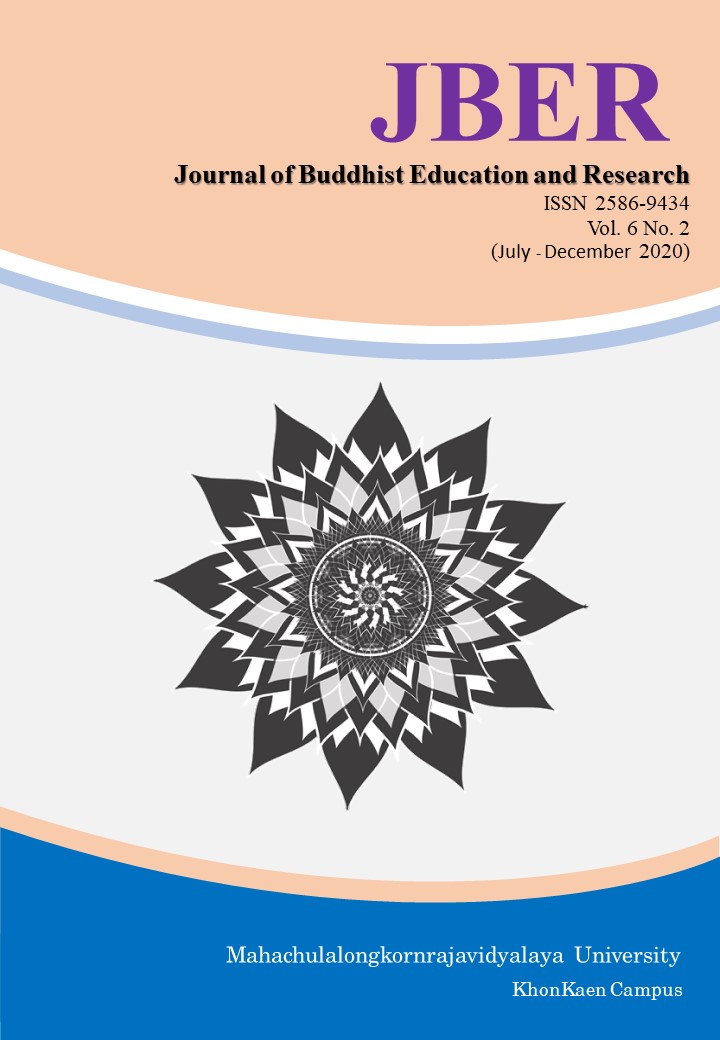Buddhist art in the Northeast : The concept of developing identity of Buddha images in the Northeast.
Keywords:
Buddhist arts; Buddhist art concepts; Buddhist arts development; Northeastern Buddhist identityAbstract
The purposes of this research were 1) to study the concepts and development of Buddhist arts in the Northeastern region 2) to study the important characteristics and the learning of Buddhist arts in the Northeastern region, and 3) to study the value and the influences of important Buddhist arts in the Northeastern region. This research was a qualitative study collecting data from both research papers and field data. 5 areas in 5 provinces in the Northeastern region were selected including Khon Kaen, Kalasin, Nong Khai, Sakon Nakhon, and Ubon Ratchathani. The data were collected from 65 monks/persons.
The results found that Buddhist arts created in the Buddha era importantly focused on the benefits and development of the individuals. Therefore, there were architectural Buddhist arts that were part of the buildings. Later in the post-Buddha era, sculptural Buddhist arts, Buddha images, were created because it was influenced by the belief of Greeks to create idols for respected gods. Buddha images were popular in the age that the Buddha’s disciples came to proclaim Buddhism during the reign of King Ashoka and when there was a contact for trading until the casting of Buddha images was popular, along with the building of temples in various regions in Thailand. Development of the Buddha image at the time Khmer prospered, there was a sandstone carving of Buddha images in different manners. There was also a building of a castle as a place to perform rituals. After that, some of the places had changed their existing beliefs into Buddhism. In the Lan Xang era, several Buddhist arts were created,
Important identity of Buddha In the Isan region, it was divided into 3 eras, Thawaravadi, Khmer and Lan Xang. And has been inherited until the present is the Lan Xang Buddhist art Due to the ethnic groups that live in It has the same culture as the Lao people, thus the traditional values are connected with the Lan Xang Buddhist art. Initial need to understand the history. And the Isan region context Which has many nationalities taking over Towards the Rattanakosin period, it was found that the ethnic still in the Isan region Still the same Lan Xang people But within the border of Thailand, Thai art has become an influence instead of the Lan Chang Buddha.
References
กรมศิลปากร. (2544). คู่มือถวายความรู้แด่พระสังฆาธิการในการดูแลรักษามรดกทางศิลปวัฒนธรรม.
(พิมพ์ครั้งที่ 3). กรุงเทพฯ: สำนักพิมพ์สมาพันธ์ จำกัด.
วิเชียร แสนมี. (2559). พัฒนาการในการสร้างพระเครื่องในภาคอีสาน. วารสารมนุษยศาสตร์ สังคมศาสตร์. 33 (2), 73-88.
ศักดิ์ชัย สายสิงห์. (2556). พระพุทธรูปในประวัติศาสตร์ไทย รูปแบบ พัฒนาการ ละความเชื่อของคนไทย. กรุงเทพมหานคร: สำนักพิมพ์สมาพันธ์.
สมบูน บุนทะวง. (2544). “พุทธศิลปะล้านช้าง” ในความสัมพันธ์ระหว่างล้านนา ล้านช้าง : กรณีศึกษา ศิลปกรรมในเมืองเชียงใหม่ลัหลวงพระบาง. เชียงใหม่ : โรงพิมพ์นพบุรี.
สุวิน ทองปั้น. (2562). พุทธศิลป์ล้านช้าง: แนวคิด พัฒนาการ คุณค่าทางศิลปะและวัฒนธรรม. วารสารธรรมทรรศน์. 19(1). 203-214.





